|
The title is meant a little tongue in cheek, Britain was never really known for its great camera industry, unless perhaps in the very early days, but it nevertheless had some well-respected brands and included some great cameras. Most of mine do not belong to this category (they tend to be pricey, even, or especially, here in the UK), but rather are part of the cheap and cheerful models characterising most of British post-war camera production. Due to their generally smaller production numbers, higher-quality British cameras such as the Ilford Advocate, the Ensign Multi, the Corfield Periflex range, let alone Reid and Wrayflex models, are equally highly-priced as highly-prized these days.
Soho Cadet
The Soho Cadet was a bakelite folding camera for 120 rollfilm sold by Soho Ltd from London in the 1930s, and as such an early smaller sized British camera, a country at the time mostly known for it large format field cameras. The Soho was similar in style and function as many German and America (notably Kodak) folding cameras from that time, with a foussing rail on the folding bed, a lens-shutter combination mounted on the lens board and a small mirror viewfinder that could be rotated 90 degrees so the camera could be used in lansscape and portrait mode. The Soho stood out because of its shiny patterned brown bakelite body, chrome metal details and burgundy red leather bellows, with the intricate decorative patterns on its body attesting to the high quality of manufacturing that was already possible at the time (1930s, almost 100 years ago!). But the camera had rather modest specifications; a meniscus lens in a single speed shutter, although a version with a better lens and shutter was also available.
The company Soho was a division of Kershaw, a somewhat better known British camera and optical equipment manufacturer, of which another folding camera can be found further down this page.

| |
The Soho Cadet, an early British folding camera with a bakelite body.
|
Purma Special
The Purma Special was introduced around 1937 and designed by Purvis and Mayo (hence the name Purma). It was a rather stylish but unusual looking camera made from bakelite which took 127 rollfilm. The Purma had a collapsible fixed focus lens as well as a fixed aperture, so exposure was purely controlled by its shutter. And herein lies the Purma's uniqueness: although the shutter was a simple spring-wound moving slit (i.e., a focal plane shutter), the way the speeds were controlled was unique. In essence, by holding the camera vertical or horizontal you would change the shutter speed, but in addition the way you held it vertical (rotating it 180 degrees) would change the speed. This system was controlled by an asymmetrical metal wheel that served two purposes: it changed the width of the slit and when held vertical, it would either counter or enhance the spring action, thus reducing or increasing the shutter speed. This resulted in a three-speed shutter with speeds of ca. 1/25, 1/150 and 1/450. For a camera of this specification that was a very fast top speed, so it is no surprise that the camera was advertised as 'the world's fastest candid camera (at its price)'.
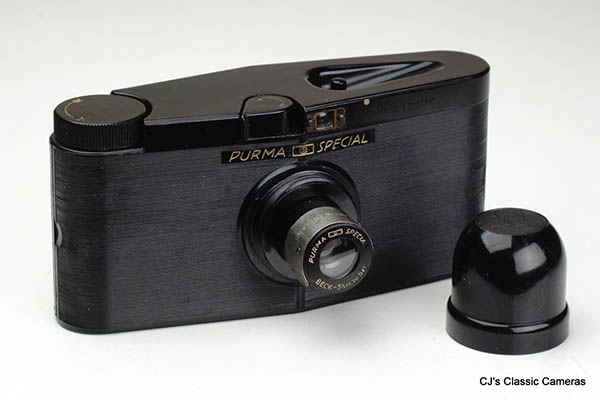
Purma with Beck Anastigmat 2 1/4" f/6.3 lens with optional close focus attachment, which allowed focus down to 3.5 ft instead of standard 12 ft.
The camera had a square 4x4 frame size, otherwise the shutter system would not have worked (or rather, landscape and portrait photos would have been made at different shutter speeds). Due to the shutter system with the moving blinds, the camera was rather big for its frame size. The camera's design was covered by several patents from as early as 1933 although the shutter speed control and body shape of the production model were different from the one pictured in the patents.
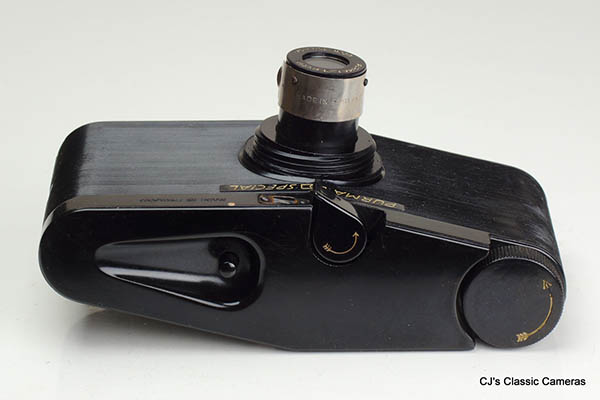
Top view of the Purma showing its unique shape, as well as the shutter cocking lever just above the lens and the recessed shutter release button.
Detailed view of (left) shutter in open position with blinds removed; (right) blinds with rotating shutter speed control wheel, here in horizontal position.
Ilford Advocate
The Ilford Advocate was the first British 35mm camera introduced after WWII. It was one of only few cameras build by Ilford themselves, the company was (and is) better known for producing film and other photographic supplies. Ilford did sell a lot of cameras in the 50s and 60s, but most of them were rebranded German cameras, like indeed the Sportsman further down this page.
In any case, the Advocate was quite an usual camera in two aspects. First of all, it was painted in an ivory enamel colour, which was quite a change from the dominantly black and chrome of other cameras from that era. Second, it had a coated four-element 35mm lens, instead of the more common 45 or 50mm lenses on other cameras. I think this is quite an underappreciated feature of the Advocate, as wide-angle lenses were quite rare at the time, certainly amongst amateur photographers. It wasn't until about 10 years later that other, mostly Japanese, manufacturers starter offering 'wide' versions of several cameras. But even though it is mentioned in ads from the time, Ilford didn't make much noise about this feature. This despite the fact that the lenses (made by Dallmeyer, although on some of the later production a Wray Lustrar can be found) must have been expensive to produce, especially since they were dedicated to one camera and produced in small numbers, and this would have driven up the price of the camera.
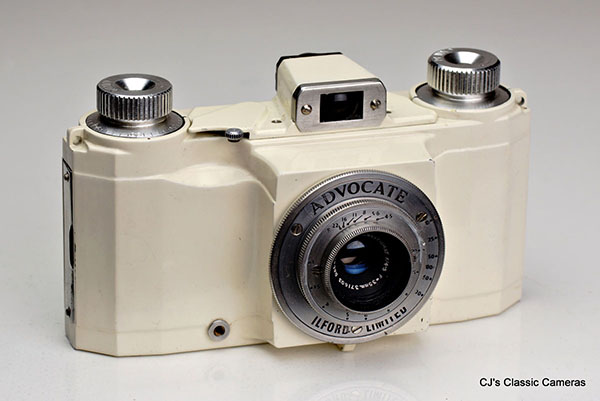
An early Ilford Advocate without flash sync sockets (the left bottom socket is a remote release socket) and with coated Dallmeyer Anastigmat 35mm f/4.5 lens.
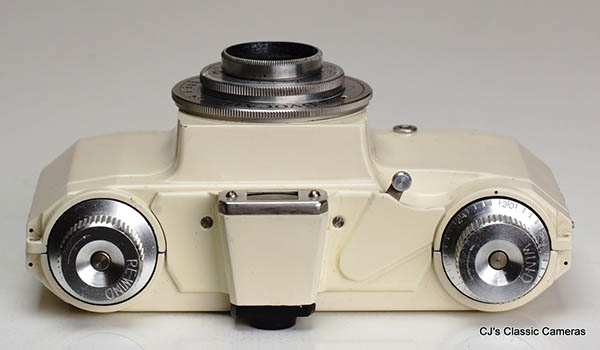
Top view of the Ilford Advocate.
The colour did probably not help the camera's popularity, as it didn't look as professional as indeed its lens was. It appears to have been aimed at women, based on them handling the camera in most ads I've seen, but it was a quite heavy and not particularly 'cute' camera. I got an opinion of one (my wife), who, when she first saw it, without being asked, said: 'what's that ugly camera?' Admittedly, she says that about most of my cameras, but she clearly wasn't endeared, and it appears neither were British women from the 1950s.
Whatever the reason, only about 10,000 Advocates were made between 1949 and 1953. Few changes occurred during production. The so-called Series II had a faster f/3.5 was fitted instead of the earlier f/4.5, and around the same time flash syncs were added to the side of the lens base. Finally, a version with black shutter face instead of the standard grey and a Wray Lustrar lens was made in small numbers.
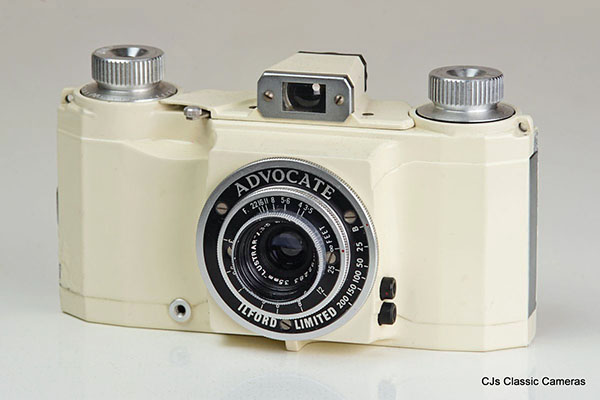
A rare version of the Ilford Advocate with black shutter plate and Wray Lustrar 35mm f/3.5 lens. Personally, I like the look of this shutter plate better. Also note the flash sync sockets at the right side of the lens base, typical of later production Advocates.
Ilford Sportsman Auto RF
Not really made in Britain but in Western Germany by Dacora, as indicated on the top housing. However, it was branded Ilford and sold as such. Dacora made many cameras for Ilford, including the Sporti and Sportsman range. The 1962 Sportsman Auto RF was one of the most highly specified models of the Sportsman range. It featured a coupled rangefinder as well as a coupled (not really automatic) light meter. The equivalent Dacora model was the Dignette E-B (German for rangefinder and light meter: Entfernungsmesser - Belichtungsmesser).
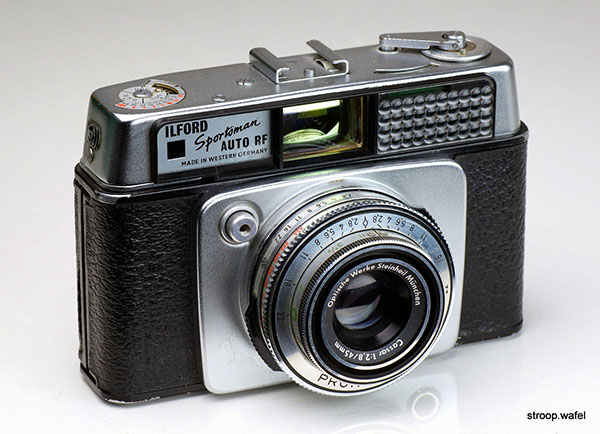
The Sportsman Auto RF with the lens marked 'Optische Werke Steinheil M nchen Cassar 1:2.8/45mm'. I have not seen the marking 'Optische Werke' on any other Steinheil lens.
AGI was a London-based lens maker that branched out into cameras for several years after WWII. The company built several folding rollfilm cameras as well as 35mm cameras and lenses sold under the name Agilux. The company still exists, although it is now based in Dorset and no longer makes cameras.
Agilux Agiflex
The Agiflex was a large 6x6 medium format reflex camera that was a very close copy of the German Kochmann Reflex Korelle. However, it was somewhat larger and heavier. It was introduced just after WWII as the production version of a similar model that Agilux had developed during WWII for military use. The camera had a focal plane shutter and an interchangeable lens mount, and was operated using a wind lever. The latter often caused problems, as it cocked the shutter using a long string which can break or become detached. However, it is possible to cock the shutter using the speed knob and the wind lever will still forward the film, so I think it could still be used with a broken string, but have not actually tried this out.
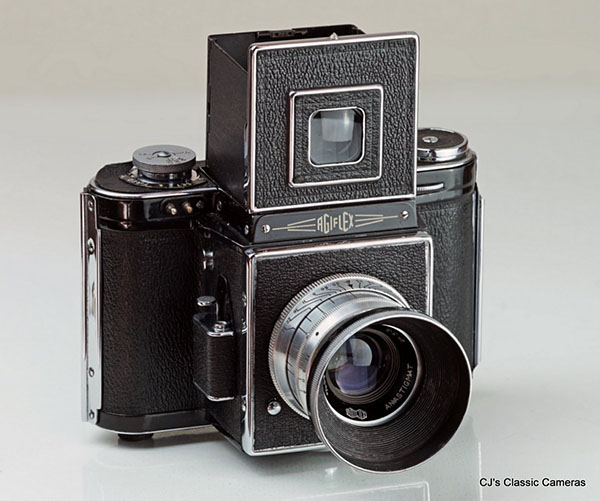
First version of the Agilux Agiflex with Agilux Anastigmat 80mm f3/.5 lens.
The original Agiflex came with a limited range of speeds of 1/25-1/500s, but a slow speeds were introduced with the Agiflex II using a separate slow speed dial. At some point a larger lens mount was introduced to allow faster lenses such as an f/2.8 standard lens. An adapter was available to mount the older lenses, but the new lenses did not fit on the older models. The mid 1950s Agiflex III had a modernised design with a chrome top plate and viewfinder, again based on the Reflex Korelle, which had gone through a similar redesign.
The Agiflex is somewhat notorious for its unreliable shutter, apparently the speeds weren't very accurate, certainly on the first model. Mine indeed doesn't work very well, but interestingly it runs fine when removed from the body. It turns out there is only very little room inside the body and as the shutter cloth is quite old it is not as flexible as it used to be, and rubs against the frame. Perhaps it even rubs with new clothes, which may explain the unreliable and too slow speeds.
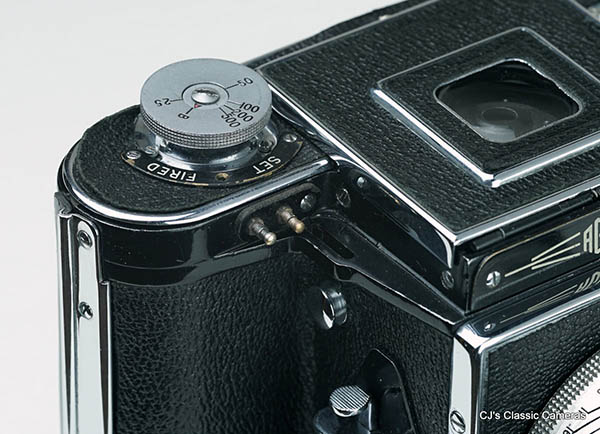
Detail showing the shutter speed dial, lacking the separate slow speed dial of later models, flash sync and shutter release just visible bottom centre.
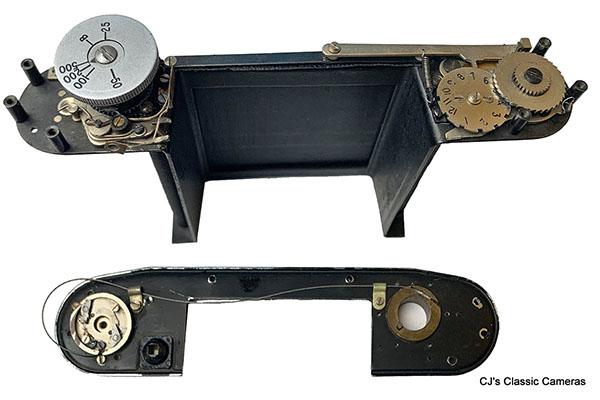
Shutter taken out of the camera, showing the film advance and frame counter on the right, the speed mechansim on the left (I remounted the shutter speed dial after taking the shutter out of the camera body). Also shown is the top plate, which is upside down and shows the wire connecting the wind lever to the shutter speed dial, which cocks the shutter when turned.
Agilux Agifold III
The Agifold was Agilux's small range of 6x6 medium format folding cameras for 120 rollfilm. It was first introduced in 1948 and this first model was a relatively simple folding camera with one special feature, a small top-view viewfinder. The Agifold II had an additional extinction meter (a special type of lightmeter) as well as uncoupled rangefinder. The Agifold III was mostly a cosmetic upgrade to a much more modern-looking camera.
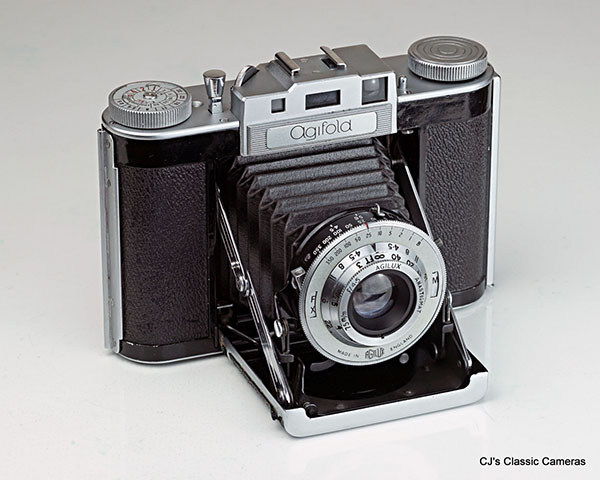
Agilux Agifold III with Agilux Anastigmat 75mm f/4.5 lens in flash-synchronised Agilux leaf shutter, similar to the shutter found on the Agimatic shown below.
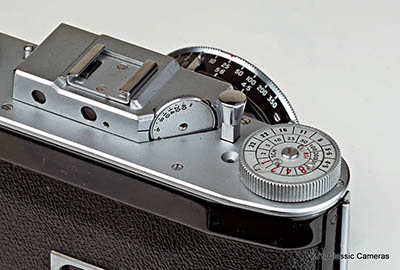
| |
Detail of rangefinder of the Agilux Agifold III. Adjustment was through the central screw in the rangefinder dial and the small hole next to the extinction meter window. What looks like a windknob is in fact the exposure calculator. One needed to turn the exposure calculator to the highest visible figure one could read in the exposure meter window
|
|
and then one could read off matching shutter speed aperture combinations.
|
Agilux Agimatic
The Agimatic was a very attractive little rangefinder camera with a few quirky features and an interchangeable lens mount. The shutter would be cocked (and film transported) by partially pushing down the cocking/shutter lever located on the lens base. Pushing the lever further would then fire the shutter. It had an uncoupled rangefinder with a dial at the back. Two lenses were available for this camera, an excellent four-element 45mm f/2.8 Anastigmat and an 85mm f/5.5 lens. A small switch at the front of the camera would insert an 85mm mask into the viewfinder window. Finally, the camera had a very convenient rewind lever.
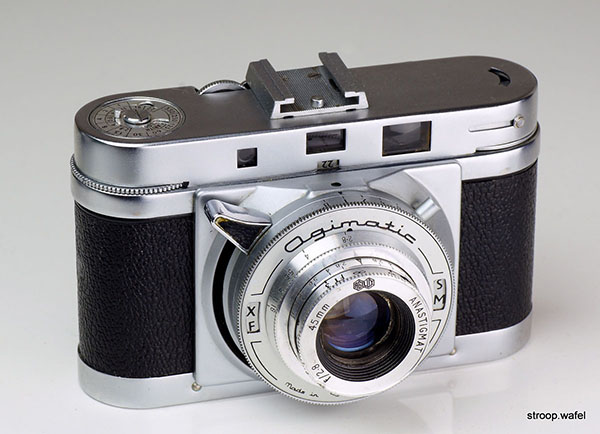
Agilux Agimatic with 45mm f/2.8 Anastigmat lens.
Agilux Agima
The Agima was an improved version of the Agimatic with large bright-line viewfinder and coupled rangefinder. It too had an interchangeable lens mount but it was different from the Agimatic, so lenses could not be used on both models. The viewfinder had frames for both the 45mm and 85 mm lenses. The main body and shutter assembly were identical to the Agimatic, so the shutter was cocked by pressing the release lever part-way down and fired by pushing the lever further. It had a coupled rangefinder.
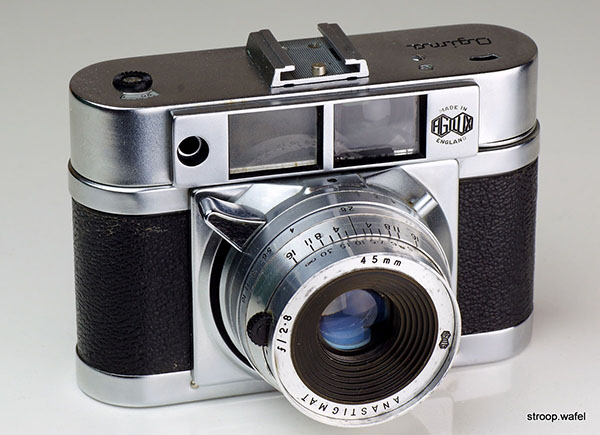
Agilux Agima with 45mm f/2.8 Anastigmat lens.
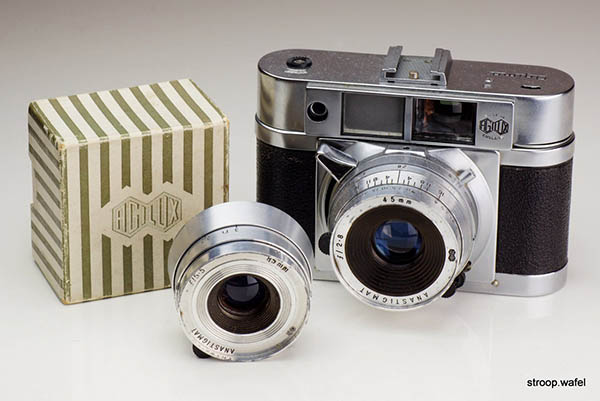
Agima with interchangeable 85mm f/5.5 Anastigmat lens and its original box. Unfortunately it is not compatible with the Agimatic mount.
Agilux Auto Flash Super 44
Later on Agilux starting making plastic cameras that were far removed from the earlier high-quality camera. One of these was the Agilux Auto Flash Super 44, introduced around 1959. It had a rather funky and unusual design somewhat reminiscent of some of the plastic Kodak Brownie cameras. It would take 4x4cm photos on 127 film and had a curved film plane like the Coronet Viscount, which made it easier to correct for lens aberations. It had a simple fixed-focus meniscus lens and a single speed shutter but did have an adjustable aperture (to be used with the flash). The camera had a selenium lightmeter and it would show the correct exposure in the viewfinder. Other cheapish cameras made by Agilux were the Agiflash, the Colt 44 and the Agimatic Instamtic camera, not to be confused with the original Agimatic above.
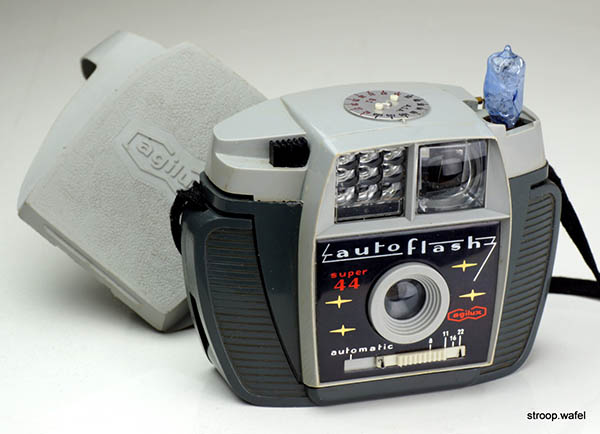
Agilux Auto Flash Super 44 camera with its matching camera cover.
Corfield was one of the more successful British camera makers, due to a unique camera line-up with a Leica screw mount. See its dedicated page here.
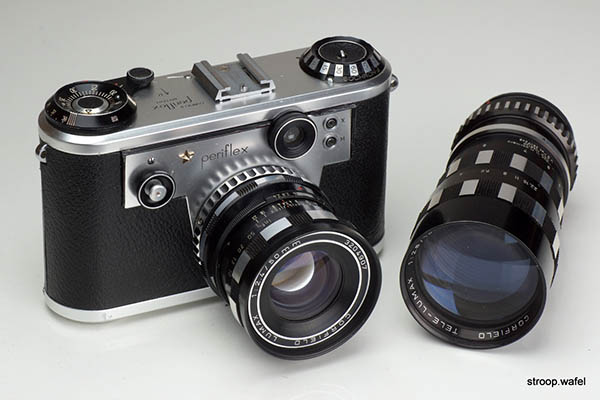
The Corfield Gold Star, probably the most popular Periflex model.
Wray London was a company founded in the mid 1850s making optical items such as binoculars and lenses. Its lenses had a good reputation and were amongst other used on e.g., the Ilford Advocate. Around WWII the company must have decided to try their hand at building cameras, with their main effort being the Wrayflex. This ended up being the only British-made SLR camera (!), but unfortunately it wasn't very successful. The first model didn't have a pentaprism, instead it projected the lens image into the viewfinder with a set of mirrors which meant the image was mirrored and somewhat dim. The Wrayflex II did have a pentaprism, which was a significant improved in functionality, but it made the camera rather awkward looking. As one would expect for an optical company, the Wrayflex did come with a good set of interchangeable lenses, but this wasn't enough to make up for its other flaws. A shame really, as I find it a very likelable camera, especially the first model, despite it somewhat inferior viewfinder.
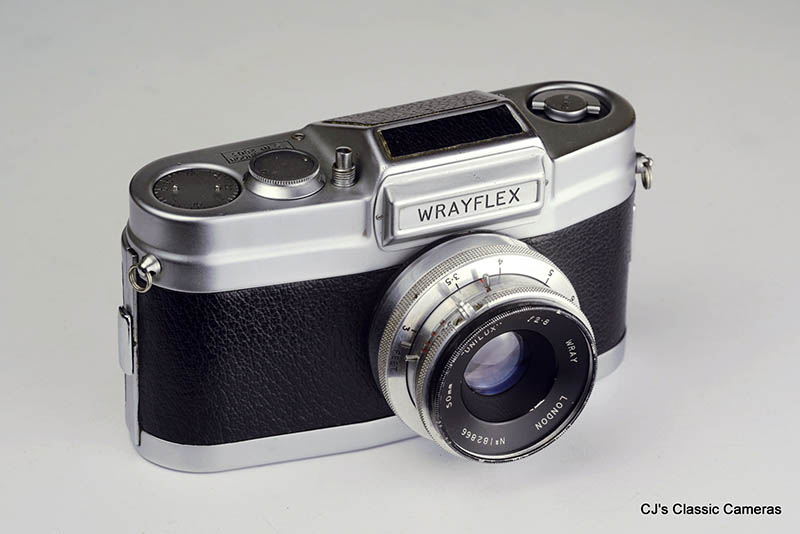
A Wrayflex Ib with Wray Unilux 50mm f/2.8 lens. Not visible in this photo is the wind key, which was underneath the camera, similar to e.g., the later Balda cameras. It was unusual, but worked very well, in fact the wind action of this camera is beautiful and amongst the smoothest of all my cameras.
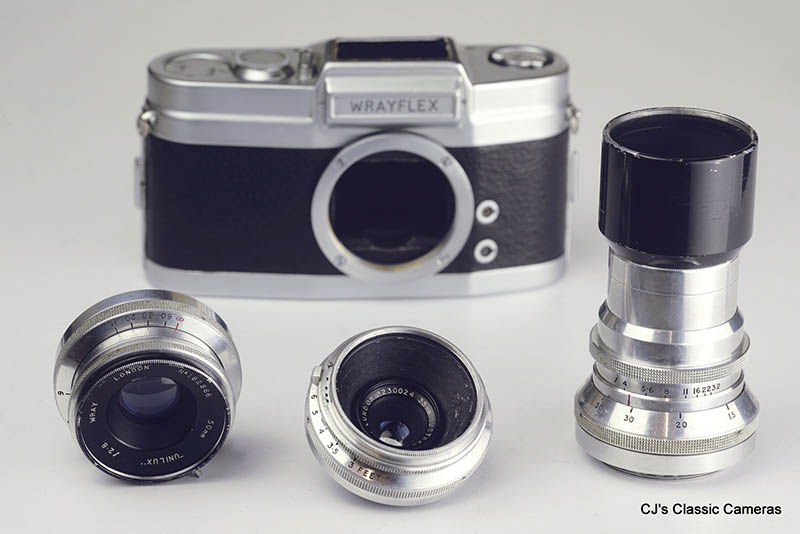
A Wrayflex Ib outfit with Wray Unilux 50mm f/2.8 lens, Wray Lustrar 35mm f/3.5 (also found as standard lens on some Ilford Advocates) and the 105 mm f/4 Lustrar telelens. All lenses had an aperture preset ring but they were fiddly to use. The telelens has a lens hood that looks like it should come off but it's impossible to remove.
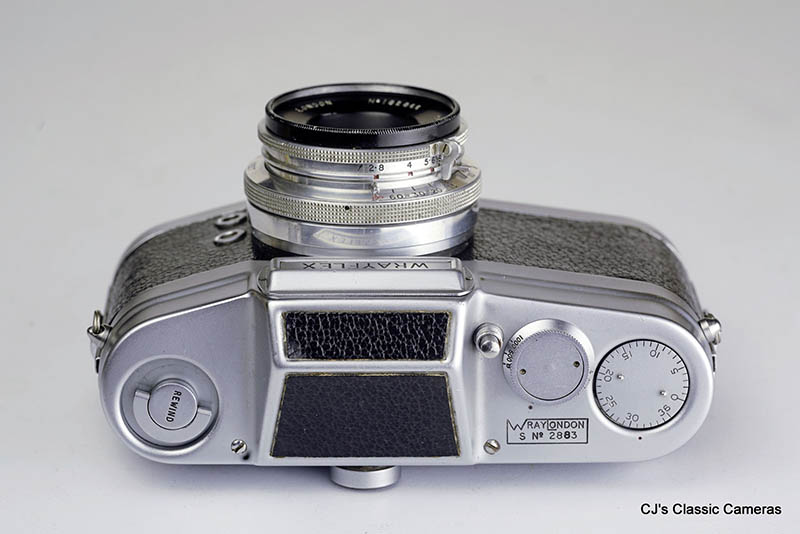
Top view of the Wrayflex Ib showing its clutterfree top deck with frame counter, shutter speed selector and rewind key. Also note the characteristic tapered body shape and off-centre lens mount, a little unusual for SLRs.
The Coronet Midget was one of the first cameras introduced by the Coronet Camera Company from Birmingham, England in the mid-1930s. This tiny camera was made of bakelite plastic and came in a variety of colours, including green, red, blue, brown and black. Not surprisingly considering its size, it was a very simple camera, having a meniscus lens with fixed aperture, no means of focussing and a single shutter speed. It had a film wind knob and a shutter release, that was about all. And a safety slide to prevent pushing the shutter accidentally. The back door was held shut by friction, so no latch either. A small spy window at the back showed the frame numbers printed on the backing paper of the Midget roll film, which was a strip of 16 mm film long enough for 6 exposures. Not to be confused with the Ensign Midget, another small British camera, but still considerably larger and using its own roll-film format, that won't fit the Coronet.
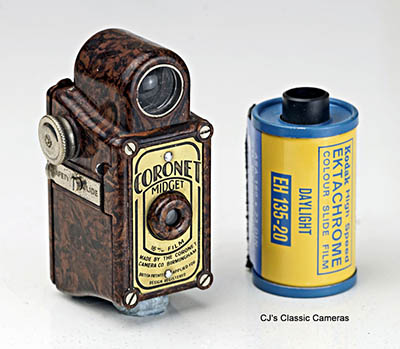
| |
A Coronet Midget next to a 35 mm film canister to show its diminutive size. It was of course too small to use this film, it used 16 mm rollfilm instead.
|
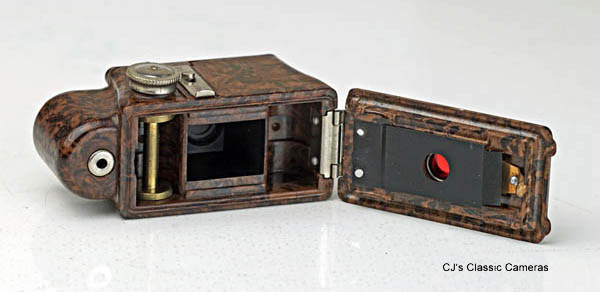
Interior of the Coronet Midget showing its film compartment with a tiny wind spool inside.
The Coronet Viscount was built from 1957 by Coronet in Birmingham, UK. It was a roll film camera that produced eight 40x27mm pictures on 828 film. It had simple controls, one had a pick of two apertures, f/8 and f/16, and two shutter speeds, 1/30s and 1/100s plus B. It had a self-cocking shutter. A second version (around 1961) missed the B setting and the aperture settings were replaced with a B&W or colour switch. They had fixed focus lenses. The camera was mostly made out of plastic and light-weight metal, but feels nonetheless pretty robust.
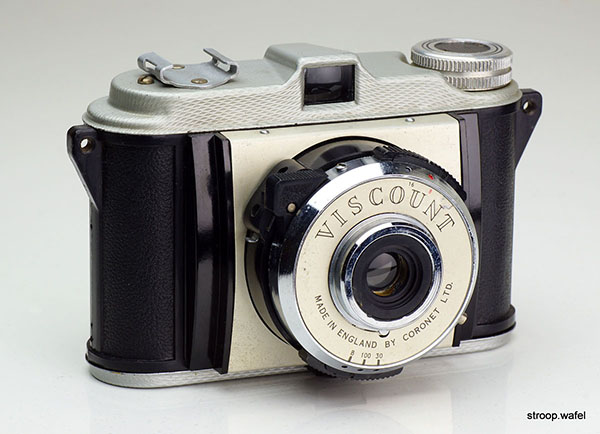
First version of the Coronet Viscount.
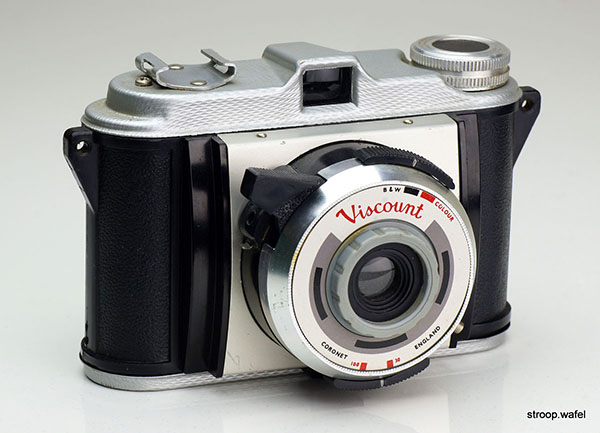
Later version of the Viscount.
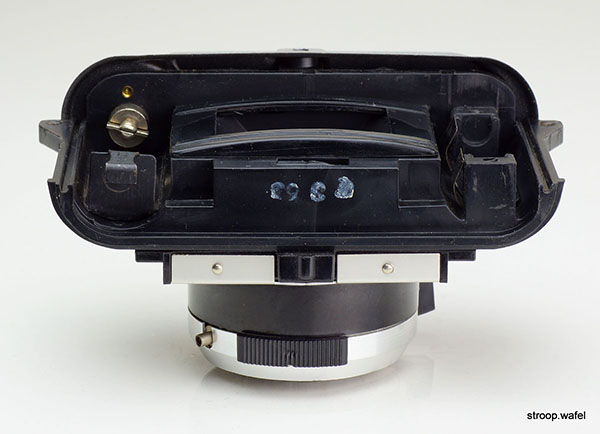
The Viscount had an interesting feature: it had a curved film plane, as visible in the photo.
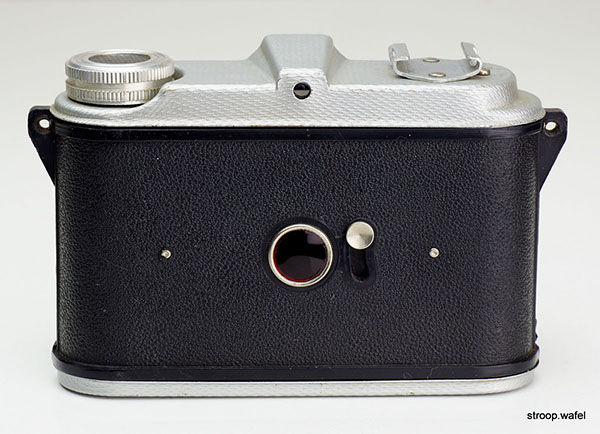
Fairly plain rear view of the Viscount.
The Coronet 6x6 was a 120 rollfilm camera with a rigid body and fixed lens, i.e., it was neither a folding camera nor a collapsible lens camera like most other 120 rollfilm cameras. It was made from hard plastic, presumably bakelite. It had a simple shutter with no aperture or speed setting at all. The instructions suggested using a flash on cloudy days...
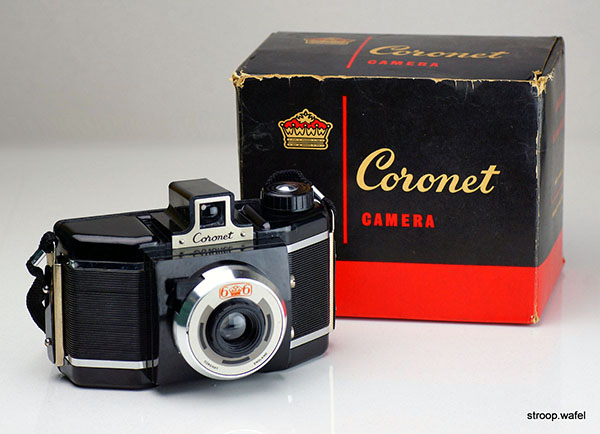
A Coronet 6x6 with its original box.
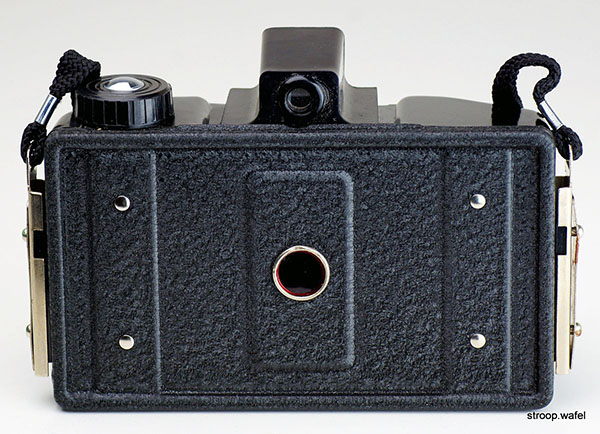
A Coronet 6x6 with its rather unusual backside.
Coronet was not the only company building simple bakelite cameras for the British market. There are several cameras with similar design features, including the Arti-Six, the Photo-Magic and Photo-Miami, and the Wembley Sport, which were marketed by Artima Export Ltd, a London-based company, but apparently made by Truvox from Wembley, Middlesex, a company specialising in plastic moulded materials as well as loudspeakers and tape-recorders. The Arti-Six is indeed very similar to the Wembley Sport, which ties together the location of Truvox (Wembley) and the marketing company Artima.
The Arti-Six was a 6x9 camera for 120 rollfilm with lens and shutter on an extending focussing helicoid. It had three aperture settings and three shutter speeds + B. The lens was marked London-Mod. XIX. A smaller variant was the Artima Photo-Magic, which was black and for 127 film, of which there was also a brown variant called the Photo-Miami. This had a lens marked Mod. IV.b, and had a similar build to the Arti-Six but with a fixed lens mount and a single shutter speed and no aperture control. The viewfinder did not even had glass in it, it was simply a direct vision plastic frame, which distinguished it from the Photo-Magic, which did have a glass viewfinder. Markings inside all these cameras were also very similar, with the film type and size indicated as well as the focus range.
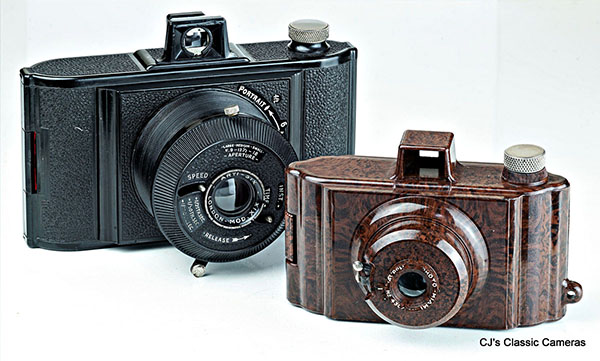
An Arti-Six with Artima Photo-Miami side by side.
Interestingly, these cameras are very similar to the Photax, made in France by MIOM from 1937. Interesting similarities are the instructions inside the camera, which includes the focus range, as well as the marking on the lens which indicate the location (Paris) as well as a model number in Roman numerals, just like the Arti-Six and Photo-Miami. The link is even clearer for the Photo-Magic, of which there is an actual French model, including a patent notice (Breveté SGDG). In fact, there is also a French black Photo-Miami model, and this name was even registered in France by the French outlet of Artima in Paris. It's unclear if the British Photo-Magic/Miami were made in France by MIOM or by Truvox, who made the the Wembley. My guess is that the pre-WWII models were made in France.
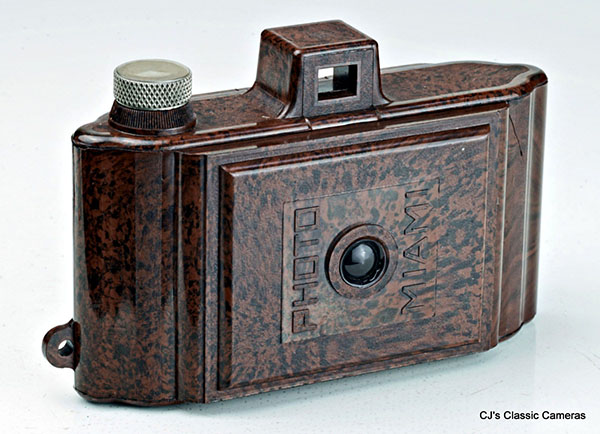
Rear view of the Photo-Miami. It appears this camera was made before WWII, around 1937. For how long and in which country (France or England) is unclear.
Folding cameras are certainly scarce on this page, but that does not mean none were made in Britain. In fact, at least two British companies made their name making folders, one being Kershaw (see below), the other was Ensign. Ensign had a complex history of mergers with many company names, but started making cameras in the early 1900s. The Ensign Selfix range was introduced in the 1930s and continued after WWII. They were folding cameras that generally used 120 film and were avaible in different frame formats. As the name indicated, the Selfix 16-20 could take 16 frames per 120 film roll, which meant a 6x4.5 cm frame size.
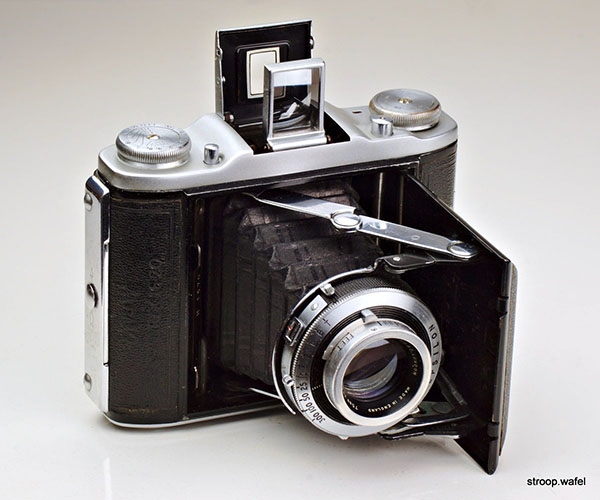
A Ensign Selfix 16-20 with Ross Xpres 75mm f/3.5 lens in Epsilon shutter. This is the second model, characterised by its metal top housing. The viewfinder was a frame finder with a frame projected in the viewfinder, which gave a better defined film frame. Other interesting features were the viewfinder which would pop open automatically when pushing the front door opening button, and the double-exposure prevention.
The Ensign Multex was a for the time very well-specified rangefinder camera for 127 rollfilm (3x4 cm) introduced in 1935. It featured a focal plane shutter with speeds from 1s down to 1/1000s. It had a telescopic lens (like on screw mount Leicas) and a closest focus of nearly 0.5m. It had several clever features including a pressure plate that was released during film winding (a similar feature was found on the Voigtlander Vitessa). The rangefinder window was magnified, so one had to frame the shot with the separate viewfinder. A variety of lenses was available, most commonly an Ensign Multar Anastigmat f/3.5 but also a Ross Express f/2.9 or a Tessar f/2.8.
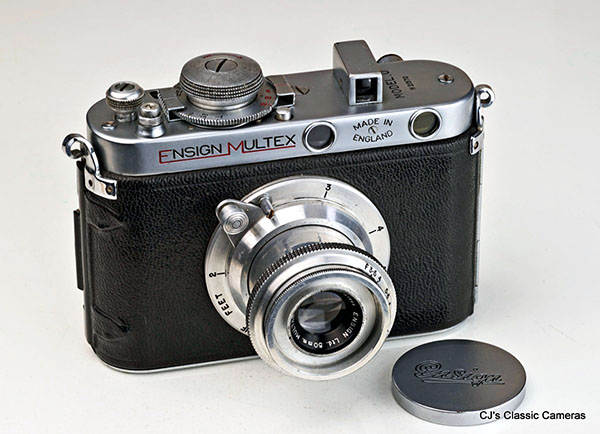
An Ensign Multex model.0 with collapsible Ensign Multar 50mm f/3.5 lens. Although the lens style is quite similar to that of the Leitz Elmar, it has a much larger 43mm thread, and doesn't fit on any other cameras that I know.
The camera was rather large for its frame size, you'd expect it to be 6x6 on 120 film but it is only 3x4 on 127.
Despite the camera being well-build, the shutter speed mechanism was rather simplistic: while winding the film and shutter, the first curtain would stop against the curtain roller; further winding would then open the gap between first and second curtains until the wind knob would come to a halt a the chosen speed. It is most likely due to this design that the Multex quickly got a reputation of being unreliable and the camera did not sell well. Nowadays they are scarce and expensive, particularly those with the rarer lenses.
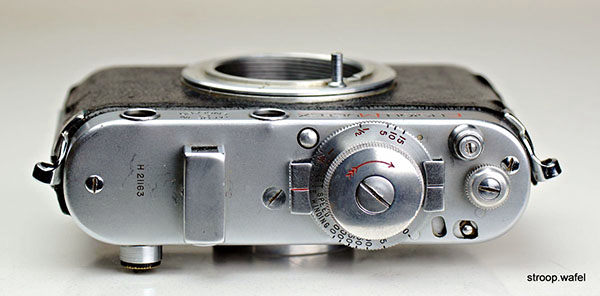
Top view of different example of the Ensign Multex (not a model. 0, although it appears to be identical and even the serial# is very close) showing the various camera controls. Most obvious is the wind/speed knob. One switches between slow and fast speeds by pushing the bar with speed markers to the left or right. The small button top left of the speed dial needs to be pushed in for the speed dial to be moved. Shutter speeds need to be set before winding, as the winding of the shutter itself determines the gap between first and second curtains, i.e., the shutter speed. The button bottom right reset the frame counter to 0.
Haking is a Hong Kong based company that still exists and has produced a varied range of cameras under the name Halina from the late 1950s onwards. Technically perhaps not British but part of the British Empire and many of the cameras were marked 'Empire Made'. The cameras were more style than substance but many have stood the test of time and are available very cheaply.
Halina 35X
This was a simple little viewfinder camera which was fairly heavy despite its small size. Its shape was obviously inspired by the screwmount Leicas but the comparison ends there. A later version with larger viewfinder was called the Halina 35X Super.
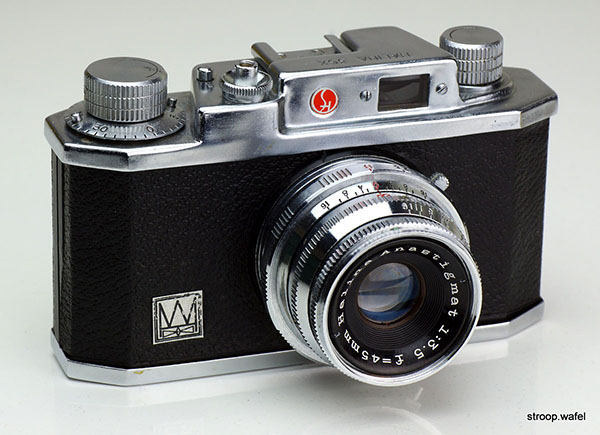
The 1959 Halina 35X looked like a shiny chrome toy version of a Leica.
Halina Paulette Electric
The Paulette Electric was a reasonably well-specified camera which included a lightmeter and a f/2.8 lens, but suffered from very poor build quality. It was fully manual, the lightmeter reading had to be transferred to the shutter.
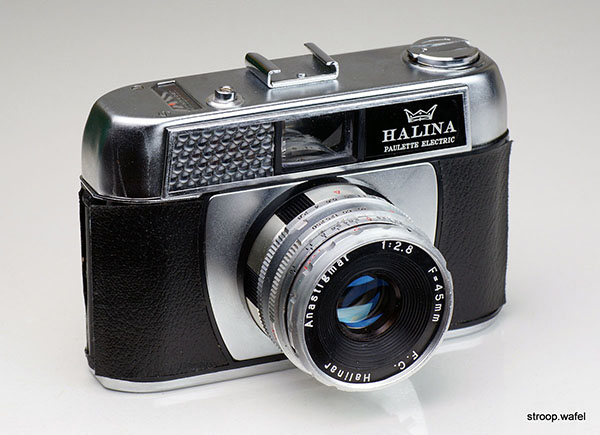
The Halina Paulette Electric, which looked rather similar to the later King Regula models.
Halina 6-4
Another simple little camera from Halina, this one from ca. 1962. It was a 120 rollfilm camera with a fairly unique feature of dual format capability, which would make 16 4x4 or 12 6x6 photos on one film. It therefore featured two viewfinder windows. The different formats were achieved by a mask in front of the film gate, so the format could not easily be changed after loading the film. It had a curved film frame like the Coronet Viscount. It had a fixed shutter speed of 1/50s with 3 aperture settings (f/8, f/11 and f/16).
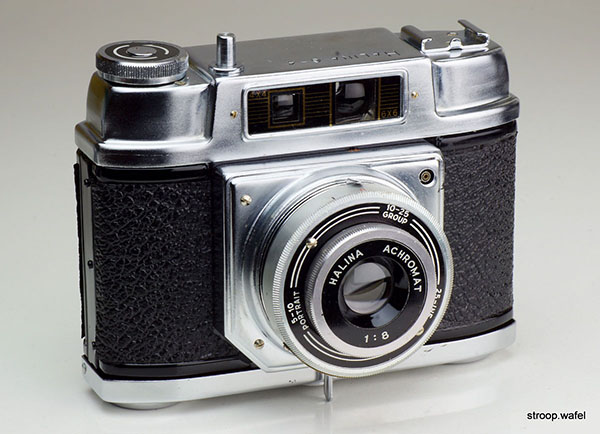
The Halina 6-4.
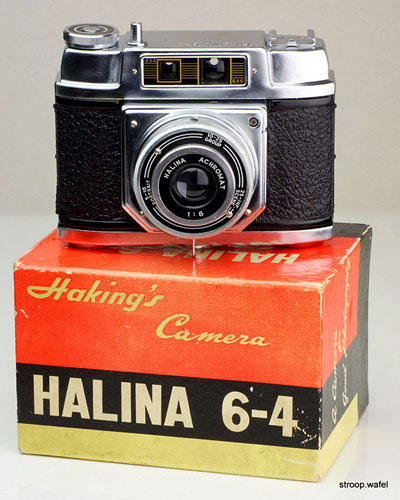 |
A Halina 6-4 with its original box.
|
Halina AI
If you like shiny chrome, you'll more than like the Halina AI. This 6x6 120 rollfilm TLR has so much of it, it is almost tacky. It is certainly eye-catching and besides than it is not a bad camera either. It is a true TLR as the focus of the viewing and taking lenses are coupled. It has a decent enough range of shutter speeds.
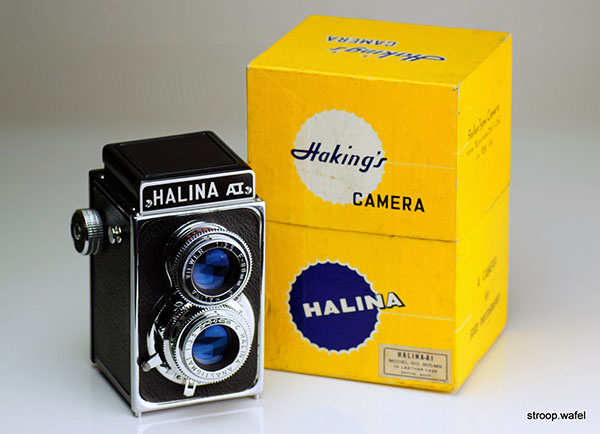
A Halina AI with Halina Anastigmat 80/3.5 taking lens and matching viewing lens.
Kershaw 630
A rather basic folding camera, certainly compared to earlier Kershaw folders such as the Peregrine, but nevertheless decently made. It looked rather cheap with a top cover of dull aluminium and plastic covering with a woven texture. Probably its most distinguishing feature was the shutter release: a small latch on the side of the lens base. It was produced around 1955 and made 12 6x6cm photos on 120 rollfilm.
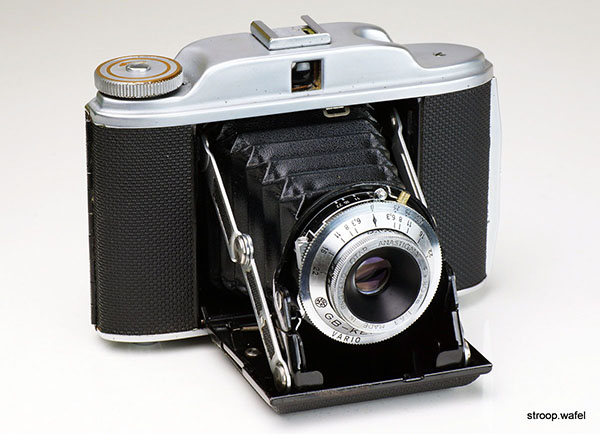
Kershaw 630 with Otar Anastigmat 80/6.3 in Vario shutter.
MPP Microcord
This camera would have fitted well on my TLR page, but it's one of the few British made TLRs so I thought it would suit better here. The Microcord was introduced in 1952 and was one of two TLRs sold by MPP, the other one was the more advanced Microflex. Both were very obviously based on their namesakes, the Rolleicord and Rolleiflex. In fact, the Microcord was almost identical to the Rolleicord II elsewhere on this site, down to the styling of the various knobs and levers, with the controls in the same place, except for the roller wheels to control aperture and shutter speed (themselves based on the Rolleiflex). It also had a similar lens bayonet as the Rolleicord so the same accessories would fit. Nevertheless, the name Micro Precision Products is prominently visible on the front plate, and the origin in Kingston on Thames, England, is clearly displayed, so I assume they were build there, and not simply rebranded or assembled from German parts (as the later MPP Iloca was).
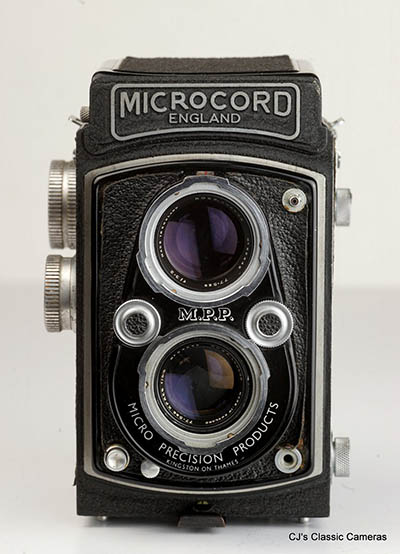
| |
MPP Microcord Mark I with Ross London Xpres 77.5 mm f/3.5 lens in Epsilon shutter, although this name wasn't marked on the camera. The viewing lens was a slightly faster f/3.2.
|
There were two slightly different version of the Microcord. The Mark I had a red window at the bottom of the camera needed to load film, whereas the Mark II had automated film loading. In addition the Mark II had a Prontor-SVS shutter and a different hood (see below).
|
Top view of the MPP Microcord with open hood showing in eye level viewfinder mode. In this mode a mirror would be flipped up (not visible in the photo) and one would look through the eye piece at the back of the hood. This allowed one to have the camera at eye level instead of at waist height whilst still observing the scene through the viewing lens. This model of hood was only available on the Microcord Mark I. For the Mark II it was replaced with a direct viewfinder mode (no mirror, just the hood's frame). Perhaps due to patent infringement? As also this feature was copied more or less without change from the Rolleicord.
| |
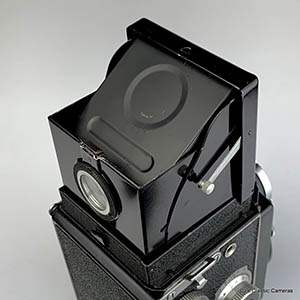
|
MPP Micro Technical Camera
Last but not least, the MPP Micro Technical Camera for 5x4 inch film. The 'Micro' part of the name feels rather tongue-in-cheek, as the camera wasn't small by any means; in fact it is by far the largest camera in my collection. The Micro Technical camera was a professional large format camera strongly based on the Graflex Pacemaker Speed Graphic, with an impressive repertoire of 'adjustments', the term for lens movements better known as tilt-shift. These adjustments allowed playing with perspective and depth of field, as well as positioning, such as taking a photo ('selfie') in the mirror without the camera being in it.
The MPP was a 5x4 plate camera (ca. 13x10 cm), so a little larger than the 9x13cm more common for German plate cameras. Like all plate cameras it had a ground glass screen for focussing, but it was also equipped with a rangefinder which worked significantly faster. The camera also had interchangeable lenses by means of a removable lens board, to which any sort of large format lens could be fitted.
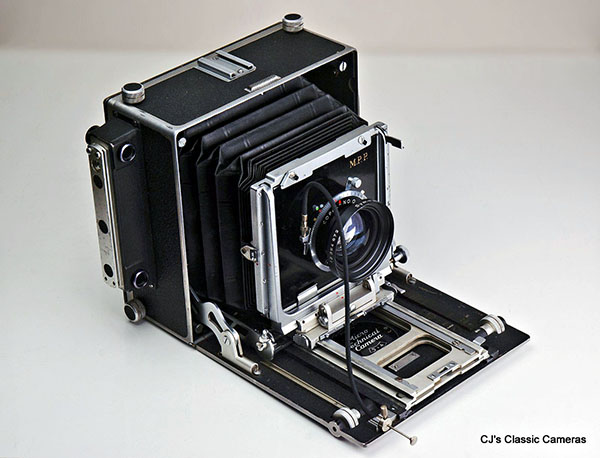
MPP Micro Technical Camera with Schneider Symmar-S 150mm f/5.6 lens (a standard focal length for this format) in Copal No. 0 shutter. This example is a late Mark VI from around 1955. Note the rangefinder unit to the left of the body.
|

